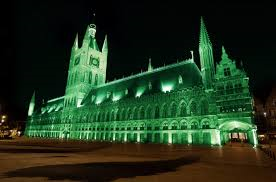(VOVWORLD) -Have you ever heard about Saint Patrick’s Day? Have you ever seen the whole river dyed green and people dressing all green for a day? Well, if you have never heard about this day, you should stay with us and our guest Greg Nelson from the US to learn more about Saint Patrick’s Day.
Hi Greg! Welcome back to VOV24/7’s Culture Rendezvous! Can you give us an introduction to Saint Patrick’s Day?
Saint Patrick's Day, or the Feast of Saint Patrick is a cultural and religious celebration held on 17 March, the traditional death date of Saint Patrick, the foremost patron saint of Ireland. It is primarily celebrated as recognition of Irish and Irish-American culture; celebrations include prominent displays of the color green, eating and drinking, religious observances, and numerous parades. The holiday has been celebrated on the North American continent since the late 18th century.
So Saint Patrick's Day is celebrated widely in the States nowadays?
Yes, of course, Saint Patrick's Day is a public holiday in the Republic of Ireland, and Northern Ireland. It is also widely celebrated around the world, especially in the United Kingdom, Canada, the United States, Brazil, Argentina, Australia and New Zealand. Saint Patrick's Day is celebrated in more countries than any other national festival.
According to the National Retail Federation, consumers in the United States spent 4.4 billion USD on St. Patrick’s Day in 2016.
Who was Patrick and why was he honored as a Saint?
Patrick was a 5th-century Romano-British Christian missionary and bishop in Ireland. Much of what is known about Saint Patrick comes from the Declaration, which was allegedly written by Patrick himself. It is believed that he was born in Roman Britain in the fourth century, into a wealthy Romano-British family. His father was a deacon and his grandfather was a priest in the Christian church. According to the Declaration, at the age of sixteen, he was kidnapped by Irish raiders and taken as a slave to Gaelic Ireland. It says that he spent six years there working as a shepherd and that during this time he "found God". The Declaration says that God told Patrick to flee to the coast, where a ship would be waiting to take him home. After making his way home, Patrick went on to become a priest. Tradition holds that he died on 17 March and was buried at Downpatrick. Over the following centuries, many legends grew up around Patrick and he became Ireland's foremost saint.
 |
Can you talk about some celebrations and traditions of Saint Patrick’s Day?
Today's St Patrick's Day celebrations have been greatly influenced by those that developed among the Irish diaspora, especially in North America. Celebrations generally involve public parades and festivals, Irish traditional music sessions, and the wearing of green attire or shamrocks. There are also formal gatherings such as banquets and dances, although these were more common in the past. St Patrick's Day parades began in North America in the 18th century but did not spread to Ireland until the 20th century. The participants generally include marching bands, the military, fire brigades, cultural organizations, charitable organizations, voluntary associations, youth groups, fraternities, and so on. However, over time, many of the parades have become more akin to a carnival.
Is that true that people are going green for Saint Patrick’s Day?
Since 2010, famous landmarks have been lit up in green on St Patrick's Day as part of Tourism Ireland's "Global Greening Initiative" or "Going Green for St Patrick´s Day". The Sydney Opera House and the Sky Tower in Auckland were the first landmarks to participate and since then over 300 landmarks in fifty countries across the globe have gone green for St Patricks day. The Irish comprise one of the largest ethnic groups in Chicago. The city has many different Saint Patrick's Day celebrations, the most famous being the dyeing of the Chicago River. Each year, the city hosts a parade downtown, which is preceded by the dyeing of the Chicago River. The dyeing of the river involves thousands of people lining the banks of the river and watching as a boat releases dye into the river and turns the river a kelly green color.
Thank you very much for talking to us today about Saint Patrick’s Day. Next week, we’ll share more interesting facts about American culture.